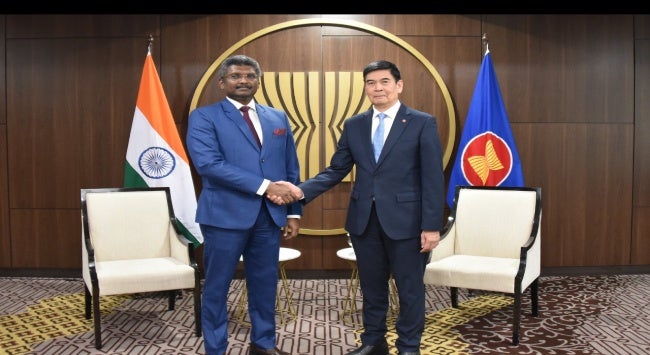Summary
Opportunities abound to advance artificial intelligence cooperation between India and the Association of Southeast Asian Nations member states, focusing on hardware, infrastructure and governance.
As the global artificial intelligence (AI) race intensifies, the United States (US) and China continue to command disproportionate attention and investment – leading many to wonder where others fit in. Yet, other countries in Asia matter to and within this race. A significant opportunity exists between the 10-member states of the Association of Southeast Asian Nations (ASEAN) and India in the realm of AI. This partnership can become far greater than the sum of its parts – a pathway toward shared prosperity, inclusive development and responsible innovation, provided both partners seize the opportunity.
India and ASEAN face similar challenges: digital-infrastructure gaps, large informal economies, complex disaster-risk environments and the need to harness technology for inclusive growth. On India’s side, the ambition is clear: to emerge as a major player in the global digital economy and to leverage AI not only for commercial gain but for social uplift, while connecting its vast, young population with the rest of Asia. When India and ASEAN cooperate on AI, they bring complementary strengths. India offers scale in talent, software capabilities and a vast domestic digital market while ASEAN bring regional diversity, robust growth rates, a strategic location bridging East and South Asia and a strong commitment to regional cooperation and multilateralism.
Moreover, the frameworks for collaboration already exist. India and ASEAN have long cooperated in science, technology and innovation through the ASEAN-India Science and Technology Working Group, which was established in 1996. This framework can be modernised and adapted for AI engagement, given that both India and ASEAN have already developed relevant governance frameworks, including the ASEAN Guide on AI Governance and Ethics and India’s AI Mission. The foundations are in place to expand discussions on this issue and make them actionable.
What might such cooperation look like? First, both parties can establish new research and innovation platforms focused on AI, bringing together universities and start-ups to create joint solutions in areas such as disaster-risk reduction, climate change, agriculture, and manufacturing. Second, both partners should double down on capacity-building and talent development. One of the major constraints in both India and ASEAN is the shortage of trained professionals able to develop and deploy AI responsibly. The focus should shift toward joint programmes, knowledge transfer through internships, researcher exchanges and training. India’s success with digital skilling and software development can serve as a valuable model; ASEAN countries, in turn, can contribute domain knowledge based on their diverse development challenges.
Third, both sides can coordinate how they regulate and govern AI. ASEAN has already articulated guiding principles and ethics frameworks for AI. India, too, is increasingly grappling with how to align innovation with trustworthiness, data protection and local values. The establishment of an ASEAN-India AI Dialogue could help define regional norms that reflect shared Asian values – rather than importing models wholesale from the West –
offering an alternative voice in global AI debates. Considerable potential exists for India and ASEAN to apply AI toward addressing developmental challenges in supply-chain management, climate resilience, cross-border data flows, cybersecurity and public health.
However, challenges remain. First, regulatory divergence looms large. The ASEAN member states vary widely in technological capacity and readiness. India is formidable but uneven across sectors. Both India and ASEAN must invest in capacity-building and engage in sustained dialogue to harmonise digital rules. AI thrives on data, but cross-border data flows, privacy laws and trust deficits can hinder cooperation. ASEAN’s digital-governance frameworks are still evolving, while India continues to balance innovation with regulation; mutually acceptable standards must, therefore, be developed.
Second, cultural and linguistic differences could constrain joint efforts. AI solutions developed in one context or language do not always translate seamlessly across borders. Ensuring local relevance will require deliberate adaptation and collaboration.
Third, resource constraints are real. AI infrastructure, compute capacity and funding remain limited compared to the leading global powers. Overcoming these gaps will require mobilising private-sector investment, leveraging multilateral financing and exploring innovative funding models.
In a global AI landscape marked by intensifying competition across the technology stack, India and ASEAN have a unique opportunity to ensure that their cooperation remains inclusive, open and self-directed – neither subsumed within nor dependent upon external spheres of influence. They can achieve this through focused, incremental progress that brings together and bridges both ecosystems – shaping an AI future that reflects their shared values and ambitions.
In the long term, India and ASEAN must move toward a broadly integrated ASEAN-India digital ecosystem with open data flows, cross-border AI deployment, shared intellectual-property frameworks and a degree of standardisation that gives the broader region influence in global AI governance. Such cooperation could position India and ASEAN not merely as passive adopters of ‘western’ AI but as shapers of how AI is used in development, regionally and globally.
. . . . .
Dr Karthik Nachiappan is a Research Fellow at the Institute of South Asian Studies (ISAS), an autonomous research institute at the National University of Singapore (NUS). He can be contacted at isaskn@nus.edu.sg. The author bears full responsibility for the facts cited and opinions expressed in this paper.
Image Credit: X
-
 More From :
More From :
-
 Tags :
Tags :
-
 Download PDF
Download PDF



